This past Saturday, I co-ran a”Genius Day” workshop for a dozen or so middle school-age kids for a local non-profit organization, the Institute for Educational Advancement. Previous “Genius Days” have focused on Darwin, Shakespeare, and William Strata Smith, and I helped out a friend last summer with some Galileo-themed activities. At first, I was little skeptical of the focus on Genius and Geniuses, because there’s so much baggage around figures in the history of science bearing that title, and because (IMHO) kids – especially ones who are constantly told they are “gifted” – don’t need added pressure to live up to an impossible ideal. So I was initially a bit worried about what I would encounter at a “Genius Day” centered on Galileo. What I did find, however, was a focus on interrogating the idea of “genius.” Impressions of the word were collected at the beginning of the day and re-examined at the end, after a series of activities and discussions and slide presentations. It was well done!
When the opportunity arose (several months later) to run one of these workshops myself, we decided to focus on Annie Jump Cannon – the first woman in the series. There are a lot of threads to Cannon’s story, and that complicates the notion of “genius” in a good, thought-provoking way. She’s a woman who worked primarily in a man’s world. Whether her employer, E. C. Pickering, was progressive or just penny-pinching for hiring women to work as researchers is a question that has no straightforward answer. She also lost most of her hearing to scarlet fever in early adulthood. Her impressive work – developing a stellar classification system and classifying hundreds of thousands of stars – was the product of decades of hard work, and understanding her achievement requires knowledge of photography (including photographic plates), prisms, spectra, and absorption lines. Having navigated all of this over five hours this past weekend, I thought it would be useful to share some of the materials that we – myself, along with Louise Hindle and Min-Ling Li at IEA – gathered and created for the workshop.
After an introductory discussion about the word “genius” and everything it might mean, we launched into a discussion of photography. I wanted to get the kids thinking about how photographs are and are not objective representations of reality. We talked a lot about how the choices they make in taking photos – even digital ones with their smartphones – influence the final product, and we connected this idea of “making” a photo (rather than “taking” one) to older forms of photography.
Then we really had a treat! Representatives from the Carnegie Observatories Cindy Hunt, Andrew Benson, and Catharine Vlahakis brought over several real photographic plates from the Mt. Wilson Observatory archives to look at. From the surface of the Moon, to spiral galaxies, to nebulae, there was plenty to marvel over, and having the physical objects there really drove home the materiality of the photographic medium. 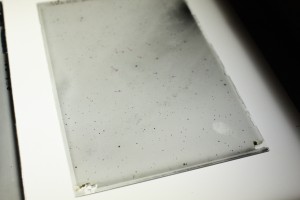 They even brought a plate from Edwin Hubble’s search for variable stars in the Andromeda Galaxy, complete with his fingerprint baked right into the photographic emulsion – talk about tangibility!
They even brought a plate from Edwin Hubble’s search for variable stars in the Andromeda Galaxy, complete with his fingerprint baked right into the photographic emulsion – talk about tangibility!
Many of the participants took photos of the plates with their phones and had fun reversing the negatives to see what they would look like to the eye, and I think some of those points about the manipulability of photographs really landed with them.
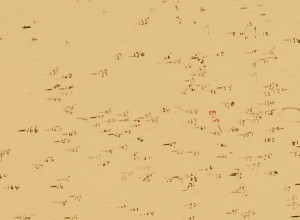 After the plate demo, we were able to bring the discussion around to the difference between the kinds of direct images on the plates we had seen and the spectroscopic plates that Cannon would have been working with. To help with this, we used an image of one of Cannon’s actual spectroscopic plates that Jonathan McDowell, an astronomer working at the Harvard Observatory (where Cannon worked) now, had very helpfully provided for us. Each of the little blurred lines is a star, the starlight having been spread out into a bar by a prism. The colors themselves didn’t make it into the photograph, but many of these spectra show clear absorption lines – gaps in the rainbow where no light is seen. Using the placement and intensity of these lines, Cannon grouped them into different star types. Looking at all of the star spectra and the careful notations, you can really get a sense of the kind of work that went into Cannon’s stellar classification system, and you can see more of the Harvard plate archives here. This image became a jumping-off point to talk about the kinds of scientific information that photographs can provide – and then it was time for lunch!
After the plate demo, we were able to bring the discussion around to the difference between the kinds of direct images on the plates we had seen and the spectroscopic plates that Cannon would have been working with. To help with this, we used an image of one of Cannon’s actual spectroscopic plates that Jonathan McDowell, an astronomer working at the Harvard Observatory (where Cannon worked) now, had very helpfully provided for us. Each of the little blurred lines is a star, the starlight having been spread out into a bar by a prism. The colors themselves didn’t make it into the photograph, but many of these spectra show clear absorption lines – gaps in the rainbow where no light is seen. Using the placement and intensity of these lines, Cannon grouped them into different star types. Looking at all of the star spectra and the careful notations, you can really get a sense of the kind of work that went into Cannon’s stellar classification system, and you can see more of the Harvard plate archives here. This image became a jumping-off point to talk about the kinds of scientific information that photographs can provide – and then it was time for lunch!
After a brief lunch break, we headed out to the Huntington’s wonderful “Beautiful Science” exhibit to see the one item in the collections1 related to Cannon: a letter she wrote to Mt. Wilson Observatory astronomer F.H. Seares in 1912. A mix of personal and professional comments, the letter was sent while Cannon was on vacation, and she writes of her current work: ” I hated to leave my catalogue with 45,000 stars classified, but so many more to do! However, my mind will be refreshed and body rested by the plunges in Old Ocean I am going to have.”
Back out on the lawn, we talked a bit about how Cannon has been described at various times, from her own lifetime to today. A brief article from 1929 describes her as an “eminent astronomer,” even while the title of the piece suggests an “invasion” of women into the field of astronomy. 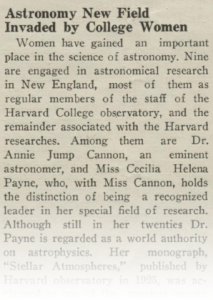 A “Wonder Women of History” comic from 1949 (part of the original Wonder Woman series) portrays her as a determined and accomplished pioneer, but adds that she loved spending time with children as well. A modern depiction from RejectedPrincesses.com shows Pickering helpfully steadying the ladder while Cannon climbs up beside a telescope, holding a wrench. All of these examples bear on how we talk about women in the history of science and women in STEM today.
A “Wonder Women of History” comic from 1949 (part of the original Wonder Woman series) portrays her as a determined and accomplished pioneer, but adds that she loved spending time with children as well. A modern depiction from RejectedPrincesses.com shows Pickering helpfully steadying the ladder while Cannon climbs up beside a telescope, holding a wrench. All of these examples bear on how we talk about women in the history of science and women in STEM today.
After heading back to the classroom, we passed out diffraction gratings (which work a lot like prisms) called Rainbow Peepholes2 and used them to look at a variety of light sources: the fluorescent lights overhead, a flashlight, white incandescent and colored LED holiday lights. Immediately engaged by the “hidden rainbows” revealed to them, the students really got into exploring the differences between the different light sources. They noticed that white light is spread out into the entire spectrum, but the red and green LEDs were just…red and green. Interestingly, the light from the purple LEDs was separated into just two colors (blue and magenta).
This activity connected directly back to the spectroscopic plates that Cannon worked with, and we followed up by attempting to classify the spectra ourselves into at least two identifiable groups.
We didn’t quite have time for the last activity – making stellar trading cards – but we sent everyone home with the materials to make their own. Here’s the trading card template I put together and a bunch of Cannon quotes about her work and the field of astronomy as she saw it. Feel free to use it, or adapt your own! I imagined using it to make a card for each star type, but you could also do it with individual stars, and I could see it working for other kinds of objects – moons, exoplanets, asteroids – too!
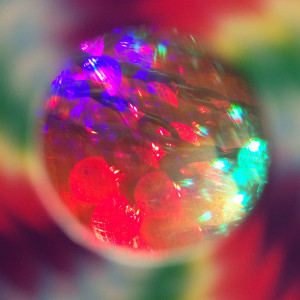 We wrapped up the day with a discussion about spectroscopy in astronomy and remote sensing today, and we talked a bit about how the spectral classes fit into our understanding of how stars evolve and what’s going on inside them. And that was it! Quite a long day, but very rewarding, and I’m happy to share all of our work putting this workshop together. If anyone else has resources to add, or would like more information on what we did, please let me know!
We wrapped up the day with a discussion about spectroscopy in astronomy and remote sensing today, and we talked a bit about how the spectral classes fit into our understanding of how stars evolve and what’s going on inside them. And that was it! Quite a long day, but very rewarding, and I’m happy to share all of our work putting this workshop together. If anyone else has resources to add, or would like more information on what we did, please let me know!

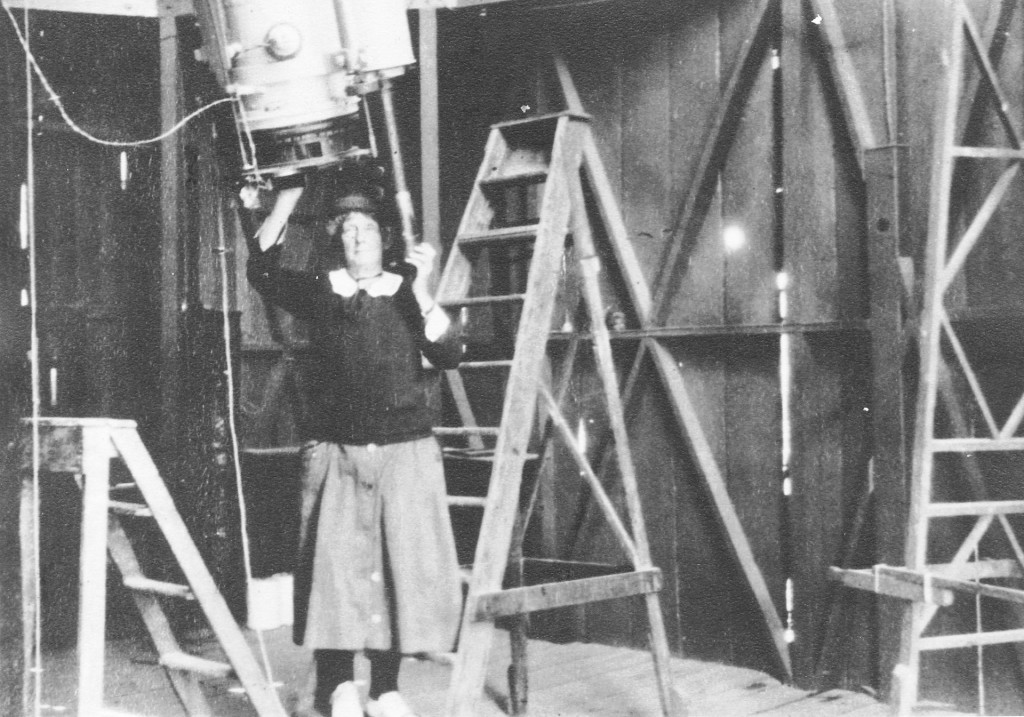
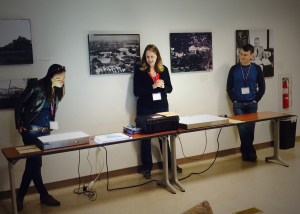
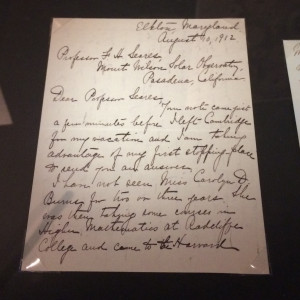
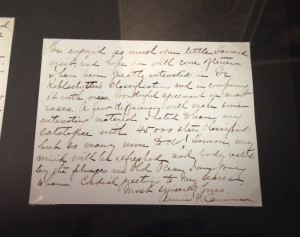
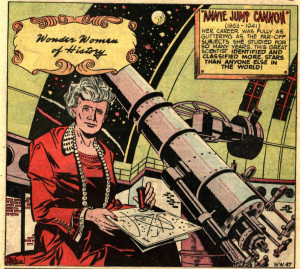
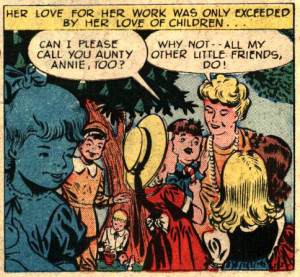
[…] True Anomalies: Exploring “Genius Day” with Annie Jump Cannon […]